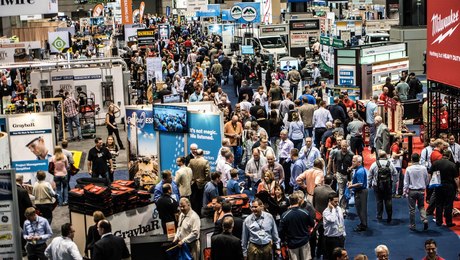
Sean McLoughlin’s new house in southern California will have a professional-size kitchen range and barbecue. He’s learned from experience the device produces “huge amounts of heat and smoke,” so he’s going to need a range hood that’s up to the job.
More from greenbuildingadvisor.com
Designing a Good Ventilation System
Ventilation Choices: Three Ways to Keep Indoor Air Fresh
What he’s got in mind is a fan that will draw 900 cubic feet of air per minute. That’s big. Unless he’s careful to provide enough makeup air, a fan of that capacity can cause a host of problems, including dangerous backdrafting in furnaces and fireplaces.
In a post in GreenBuildingAdvisor’s Q&A forum, McLoughlin wonders aloud whether the HVAC system can be configured to bring in replacement air for the range hood.
But a better solution seems to lie with a damper made by Broan that opens automatically when the range hood fan is turned on. The fine points of the design are the subject of this week’s Q&A Spotlight.
Read the whole article at Green Building Advisor
Fine Homebuilding Recommended Products
Fine Homebuilding receives a commission for items purchased through links on this site, including Amazon Associates and other affiliate advertising programs.

Reliable Crimp Connectors

8067 All-Weather Flashing Tape

Affordable IR Camera



























View Comments
Here is the article's URL to say you from having to search for it http://www.greenbuildingadvisor.com/community/forum/mechanicals/22281/make-air-900-cfm-range-exhaust-hood
FINALLY people are starting to find answers for this problem!!! I've been trying to find an affordable solution to this for years. Looks like I'll be in research mode once again. Hopefully this pencils out.
Seems to me, in SoCal, the right way to do this would be to design an indoor/outdoor kitchen so that the whole need for a 900CFM fan exhausting conditioned air from a kitchen goes away. The comments on GBA's web site all seem to be leaning that way as well...
As homebuilders and homeowners, we really need to step back and look at the big picture - just because we can have an indoor BBQ (or a 40 GPM rain forest shower experience (http://www.houseinteriordesign.net/the-design-of-luxurious-shower-for-your-bathroom/) or an indoor ski mountain (http://www.skidxb.com/home/about-ski-dubai/virtual-tours.aspx) doesn't mean that we should.
Just say "no thank you" to this kind of conspicuous consumption and energy waste - generations to come will thank you...
-John
You may want to check out the Armchair Builder article from September for some insight. I like where John is going with this one...simple is sometimes the best policy. If you're going with the massive indoor fan, here is the article link...
http://blog.armchairbuilder.com/2011/09/22/range-hood-fans-can-be-dangerous/
John:
Thanks for voicing the very real concerns about the 'big picture' regarding wasteful energy and resource consumption. How much longer do we want to remain beholding to foreign sources of energy?
40 gpm rain forest shower heads? Disgusting! The short supply of water has already reached a crisis level in many American states as their sources dwindle to a trickle. Do we have to get to that point before we wake up?
While I agree with John and and docmartin that we should be conscious of our consumption and limit it to what we really need and use, I emphatically disagree that designing a kitchen to cook real food leads to defacto overconsumption. Real food does not come from boxes, cans, or bags. If you want to cook real food, you are going to make some smoke. And wagging your finger at an individual who is designing a functional kitchen because they want to cook, is like telling a woodworker that he doesn't "need" a tablesaw and dust collector because he can do everything outdoors with a handsaw and chisel.
I am a strong advocate of sustainable building, tightly sealed building envelopes, and energy sustainability. But opening a window while cooking is not the answer ... at least not in the North where winters hover between 10 - 25 degrees F. (In Southern California where the question arose, that is not necessarily the case) Nor am I going to change my diet to salads and ramen noodles for the sake of indoor air quality. A strong hood and well-designed make-up air system are essential to removing odors and smoke from the home when cooking food that generates smoke i.e. searing, frying, deglazing, reducing, and broiling. If you believe that 350 cfm is adequate, go check out the hood at your neighborhood restaurant. When balanced, the impact on home heating energy consumption will be deminimus for the time that it is actually in use. Equating cooking with over-consumption is short-sighted. In my home, we cook almost every meal and dine out very rarely. Could we survive with only a crockpot and microwave? Sure. But it would sure be a waste of our garden, orchard, and game that we harvest from our farm.
Unfortunately, I have not found where residential designers and appliance manufacturers have come up with a good solution. Where residential fails, I turn to commercial. A helpful resource that I have used is the Guide to Optimizing Commercial Kitchen Ventilation, and the design guide at http://www.foodservicetechnologycenter.com/ventilation/designguides/.
jp
i'd scecond JP's points. As one who loves to cook and rarely eats out, I also invested in a professional cooktop and hood, although makeup air is not an issue at this point because ongoing remodeling creates enough air infiltration to provide more than enough of it. Nowadays, kitchens are the most central rooms in our homes, as their function has moved from solely a practical to a multipurpose bent. They act as areas of cooking, cleaning, reading, homework, entertaining, and even play and work. The results of which, whether atmospheric or physical reach every other part of the house before spreading outwards. Some invest in expensive furnishing made from imported rare wood, luxury cars and planes, others in patronizing expensive eateries that serve food that is grown or harvested without care for the environment, others further, invest in cooking equipment that help them make good, joyful food to feed their family and friends and in the process make a haven of their home. Who would your rather be?
I AGREE with limace - comment #1 -- let's just be a little more REAL with our needs, instead of wants. There's no need to vent your entire house just because you want to fire up a jet-propulsion-sized burner. Sheesh, if you want to cook using a range more fit for a science-experiment do it outside, and NOT on a daily basis!
I see some on track comments and some way off base.
If you need 900CFM maximum this doesn't mean you need 900CFM all the time. Answer: Variable speed exhaust.
Next, air is coming from somewhere to make up for the loss when the fan is running.If your house is tight it comes through cracks, down your chimney for the fireplace or the first open door or window.
But, if you are thinking and cooking heavily then you can install a make up air damper to allow air to come in when the hood is running and preferably since you will not condition that air the makeup air outlet is located just before the filters on the exhaust fan so you really aren't wasting energy from conditioned air in the home. The smoke mixes with the outside air and is vented.
If in colder climates where very cold air may escape the hood capture area into the room, certain heat exchangers could be used which take the heat from the exhaust air and transfer it to the incoming air. However, exhaust air is typically grease laden so you need very good filtering. Otherwise, plan on much maintenance.
Likely good and reasonably efficient results come from slightly under-sizing the properly ducted or fan powered outside air intake CFM to be a little less than the exhaust air with a damper that closes when the exhaust fan is off.
As homes get tighter through the use of ICFs, SIPs and even improved stick building practices, make up air becomes critically important. Simply opening up a hole in the side of a home as the Broan duct does is not a solution for most climates in the world. It amazes me that an article on make up air could be written and several assumed experts quoted that does not even mention heat-recovery ventilators (HRVs) and energy recovery ventilators (ERVs). Several manufacturers produce these units, but I have not yet seen any practical, real world data on the effectiveness of these subsystems, nor do I understand why the industry has been so slow to warm up to this technology.